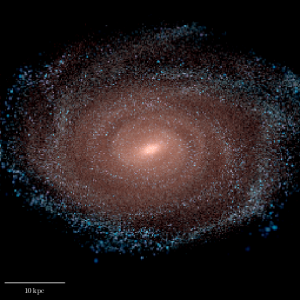Library of galaxy histories reconstructed from motions of stars

The CALIFA survey allows to map the orbits of the stars of a sample of 300 galaxies, a fundamental information to know how they formed and evolved. HITS astrophysicists have collaborated in this project that was led by the Instituto de Astrofísica de Andalucía, Spain. The results have been published in “Nature Astronomy.”
See also the press release from the Instituto de Astrofísica de Andalucía (IAA-CSIC), Spain
Just like the Sun is moving in our galaxy, the Milky Way, all the stars in galaxies are moving, but with very different orbits: some of the stars have strong rotations, while others may be moving randomly with no clear rotation. Comparing the fraction of stars on different orbits we can find out how galaxies form and evolve. An international team of astronomers, among them Dandan Xu and Robert Grand from the Theoretical Astrophysics group (TAP) at HITS, has derived directly, for the first time, the orbital distribution of a galaxy sample, containing more than 300 galaxies of the local universe. AmonThe results, published in Nature Astronomy, are based on the CALIFA survey, a project developed at Calar Alto Observatory and conceived from the Institute of Astrophysics of Andalusia (IAA-CSIC).
Galaxies are the largest structures in the universe, and scientist study how they evolve to understand the history of the universe. Galaxy formation entails the hierarchical assembly of halos of dark matter (a type of matter that has not been directly observed and whose existence and properties are inferred from its gravitational effects), along with the condensation of normal matter at the halos’ center, where stellar formation takes place. Stars that formed from a settled, thin gas disk and then lived though dynamically quiescent times will present near circular orbits, while stars with random motions are the result of turbulent environments, either at birth or later, with galactic mergers.
Thus, the motions of stars in a galaxy are like a history book; they record the information about their birth and growth environment, and it may tell us how the galaxy was formed. “However, the motion of each single star is not directly observable in external galaxies. External galaxies are projected on the observational plane as an image and we cannot resolve the discrete stars in it,” says Ling Zhu, researcher from the Max Planck Institute for Astronomy who leads the study. “The CALIFA survey uses a recently developed technique, integral field spectroscopy, which can observe the external galaxies in such a way that it provides the overall motion of stars. Thus, we can get kinematic maps of each galaxy.”
The researchers then build models for each galaxy by superposing stars on different types of orbits. By constraining the model with the observed image and kinematic maps, they can find out the amount of stars moving on different types of orbits in each galaxy. They call it the stellar orbit distribution and, for this study, the team has built models for all 300 galaxies, representative of the general properties of galaxies in the local universe.
The maps show changes in galactic orbit distribution depending on the total stellar mass of the galaxies. The ordered-rotating orbits are most prominent in galaxies with total stellar masses of 10 billion solar masses, and least important for the most massive ones. Random-motion orbits unsurprisingly dominate the most massive galaxies (more than 100 billion solar masses). “This is the first orbit-based mass sequence across all morphological types. It includes flourishing information of a galaxy’s past, basically whether it had been a quiet succession of only smaller mergers or shaped by a violent major merger. Further studies are needed to understand the details,” says Glenn van de Ven (ESO).
The researchers had found a new and accurate method of reading off a galaxy’s history — and their survey with its data sets for 300 galaxies turned out to be the largest existing library of galaxy history books.
“This work highlights the importance of integral field spectroscopy and, in particular, of large-scale surveys such as the CALIFA project. The significant contribution of what we call ‘hot’ orbits, a mixture of rotation and random movements of the stellar component, poses important challenges to cosmological models of galaxy formation and evolution,” says Rubén García Benito, a researcher at the Institute of Astrophysics of Andalusia (IAA-CSIC) participating in the project.
CALIFA’s results represent an observationally-determined orbit distribution of galaxies in the present-day universe. They lend themselves thus to direct comparison with samples of cosmological simulations of galaxies in a cosmological context. In this sense, these results open a new window for comparing galaxy simulations to the observed galaxy population in the present-day universe.
See the CALIFA Youtube video
Contact:
Silbia López de Lacalle
Instituto de Astrofísica de Andalucía (IAA-CSIC)
+34 958 230 676
silbialo@iaa.es
Reference:
“The Stellar Orbit Distribution in Present-Day Galaxies Inferred from the CALIFA Survey,” Ling Zhu et al., 2018 Jan. 1, Nature Astronomy [https://doi.org/10.1038/s41550-017-0348-1, preprint: https://arxiv.org/abs/1711.06728].
Authors:
Ling Zhu, Glenn van de Ven, Remco van den Bosch, Hans-Walter Rix, Mariya Lyubenova, Jesús Falcón-Barroso, Marie Martig, Shude Mao, DanDan Xu, Yunpeng Jin, Aura Obreja, Robert J. J. Grand, Aaron A. Dutton, Andrea V. Maccio, Facundo A. Gómez, Jakob C. Walcher, Rubén García-Benito, Stefano Zibetti, Sebastian F. Sánchez.
About HITS
HITS, the Heidelberg Institute for Theoretical Studies, was established in 2010 by physicist and SAP co-founder Klaus Tschira (1940-2015) and the Klaus Tschira Foundation as a private, non-profit research institute. HITS conducts basic research in the natural, mathematical, and computer sciences. Major research directions include complex simulations across scales, making sense of data, and enabling science via computational research. Application areas range from molecular biology to astrophysics. An essential characteristic of the Institute is interdisciplinarity, implemented in numerous cross-group and cross-disciplinary projects. The base funding of HITS is provided by the Klaus Tschira Foundation.